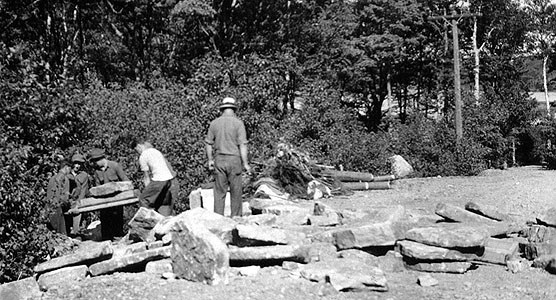
Photo courtesy of National Archives and Records Administration The year is 1933, and the country is mired in the darkest days of the Great Depression. President Franklin Delano Roosevelt has just taken office after a landslide victory, promising a “New Deal” for the American people. He seems optimistic, but for most hope is hard to find. Many are on welfare, waiting in bread lines or at soup kitchens. Others beg from door to door for food or spare change to feed their families. One out of every four workers is unemployed. Creation of the CCCThose were the days of desperation out of which the Civilian Conservation Corps (CCC) was created. Roosevelt saw an opportunity to mobilize hundreds of thousands of young men and put them to work in the service of nature. This “Tree Army,” as it became known, would be stationed in forests, parks, and rangelands throughout the United States and complete projects that would benefit both the land and CCC participants. In a letter to Congress, FDR wrote, “More important, however, than the material gains, will be the moral and spiritual value of such work.” It was a time when people needed not just a job, but a purpose. Within three months after the bill was signed, approximately 275,000 young men were enrolled in the CCC looking for work and a way to provide for their families. As one of the “boys,” you were paid $30 per month, $25 of which was sent directly home. In return, you were expected to work six days a week, live in camp, and abide by the rules. At the end of the day, the food was hot and plentiful. Many were getting three square meals a day for the first time in their lives. 
Courtesy National Park Service/Acadia National Park Contributions to AcadiaThe American people weren’t the only ones facing hard times. Across the country, natural resources were being lost to poor conservation, heavy use, and severe drought. In Maine, one of the newer national parks was struggling. Even though Acadia National Park had been created 17 years earlier, it was still rural, small, and undeveloped. Most areas were overgrown and inaccessible, and the facilities were inadequate for the park’s large number of visitors. Superintendent George Dorr desperately wanted to develop the area and saw a huge opportunity in the CCC. He petitioned Roosevelt for a camp to be stationed at Acadia. His wish became reality when one of the program’s earliest camps was established at Eagle Lake, the current site of park headquarters. Soon a second camp was established near Southwest Harbor, the Great Pond Camp. Out of more than 4,000 camps that would eventually be created, only 100 would run the entire span of the program, including the two on Mount Desert Island. During the nine years the CCC was stationed at Acadia, they completed hundreds of projects. The majority of these were in forestry, such as fire fighting, fuel reduction, and disease control. The “boys” also performed most of the work in constructing the park’s two campgrounds, Blackwoods and Seawall. Their most enduring and endearing successes, though, are the stunning and unusual trails that lead hikers into the heart of Acadia, such as the Ocean Path and Perpendicular Trail. Granite blocks weighing more than a ton were carefully cut and laid by hand. Thousands of dead or downed trees were cleared. The work was hard, but fulfilling, and through their efforts, the CCC opened, protected, and beautified Acadia National Park. Even though the program ended in 1942, the legacy of the Civilian Conservation Corps lives on. More than three million participants gained new skills that they could use to find work or build a career. Hundreds of millions of trees were planted in forests across the country. Thousands of miles of trails were built. Out of America’s dark days came the largest conservation project and peacetime mobilization in history. It was a unique movement to restore, cherish, and save our treasured places. The benefits to the men and the land were many, but the ones who benefit the most are those who come after—the visitors of today and of future generations. They will walk the trails, camp under the stars, and sit in the shade of the trees. They are the most fortunate. They represent the Tree Army’s greatest success. More Information |
Last updated: August 1, 2025
